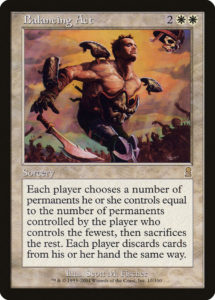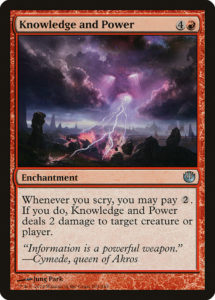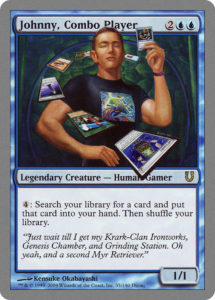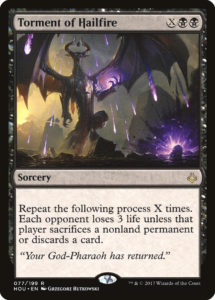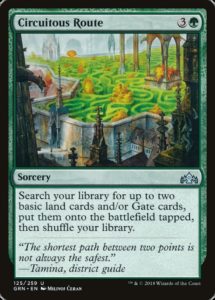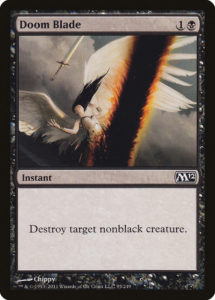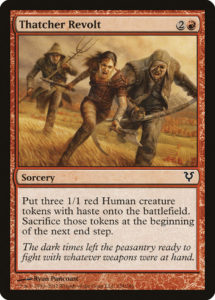Welcome back, friends! Last week, we reviewed the mechanics of Guilds of Ravnica. This week, we’ll review the Limited format as a whole. Finally, next week, we’ll cap it off by the full set review (and probably more than a bit of speculation about Ultimate Masters Limited). We’ll test GRN against the same six criteria we used to crown Dominaria as a masterpiece: Balance, Power, Archetypes/Synergy, Replayability, Fixing, and Interaction, defining each criterion as we go. Let’s kick things off with balance!
Balance
How wide the power disparity is across different colors, color combinations, and archetypes. A more balanced format has more viable decks; a less balanced format has fewer options. In general, more balance is better (though I recognize a lot of these categories will vary based on personal preference).
Ravnica is a reasonably balanced format. Blue is probably the best color, but a well-functioning Boros deck can dominate the competition. There is counterplay to both Dimir control and Boros Mentor hyperaggro, making no archetype truly dominant. If you’re in Boros, Dimir, or Izzet, you’ve got tools to help you beat the rest of the format.
Green, however, seems to be very weak. Yes, there are lots of strong Golgari cards (which Dimir drafters competing with each other are happy to snatch up), and Siege Wurm is still a powerful card; but green has far fewer options, play patterns, and powerful cards (particularly at common) than the other colors. Much of this is due to both green guild’s mechanics producing below-rate creatures that require setup to function (Convoke tends to add about 1 mana for each 4 mana a card costs and Undergrowth creatures tend to cost 4+ mana and require at least two dead creatures before you get a real benefit). Because both guilds are so focused on creature cards, every noncreature spell comes with a huge deckbuilding cost—that’s one less card to fuel Convoke and Undergrowth. Furthermore, both guilds are about building one giant monster, and in a format with as good removal as GRN, it’s very common for a player to work hard to play a turn 4 Siege Wurm, only for it to die immediately (every color other than green has at least one common answer to Siege Wurm that’s mana efficient), and then they’re stuck with a board of lackluster threats.
Guilds of Ravnica is a fairly unbalanced format. It’s nowhere near as egregious as Battle for Zendikar, where green was essentially unplayable; but it’s not great. Blue, red, and black are deep enough to support a large majority of players at a table, but the strong weakness of a single color bleeding into 2/5 guilds definitely unbalances the format.
Balance Rating: C+
Power (or relative power level)
What percentage of cards at each rarity are excellent, decent, and awful, and how big a difference there is between excellent and awful cards. A more powerful format has a ton of swingy cards (such as Mist Raven in Avacyn Restored or the plethora of bomb rares in Fate Reforged); a less powerful format has fewer cards able to take over the game (and oftentimes, but not always, more unplayable commons). Some formats have high overall power (like Modern Masters 2013), but are ranked as having lower power because the difference between the best and worst cards, particularly at common, isn’t enormous. My preference is usually for formats with relatively even power level (meaning many cards are playable) rather than formats with small numbers of playable cards or a small number of cards that completely overwhelm everything else.
Guilds of Ravnica is a pretty balanced format in terms of power. Sure, there are some outliers, like the disgustingly strong Nightveil Predator; but creatures are fairly small, allowing for a large diversity of playable creatures. Skyknight Legionnaire, Goblin Electromancer, and Artful Takedown are excellent, irreplaceable commons, but they’re not so embarrassingly strong that weak cards like Wojek Halberdier, Severed Strands, and Fire Urchin are unplayable. I really appreciate that so many cards are playable in Guilds of Ravnica, and much of that is thanks to the small average size of creatures and each mechanic subtly shifting card evaluations. I think green could use a bit of a bump in terms of power, and that’d help its rating both in this section and above.
Power Rating: B+
Archetypes/Synergy
Whether players are encouraged to draft archetypes (where a card’s value is determined by what other cards it interacts with) or ‘good stuff’ (where cards behave and are valued similarly across color combinations). Ixalan and Modern Masters 2013 are very high synergy formats where you essentially must commit to an archetype, Innistrad is a medium-high synergy format where you are rewarded for being in an archetype but can play a goodstuff deck, and most core sets are low synergy formats (though Magic Origins bucked this trend). I prefer formats with dynamic pick orders, where players in one color (or, in GRN’s case, guild) value cards differently based on what their decks are trying to do.
Ravnica sets tend to be geared towards somewhat rigid archetypes. While the mechanics and their execution don’t always lend themselves to be built around (see: Radiance, Replicate, Bloodrush, Detain for a few examples), drafters are basically mandated to be in one of the available guilds. There simply isn’t enough support to play the five unsupported guilds (in GRN’s case).
Well, Guilds of Ravnica has a bit of brilliant design: all of its guilds (well, only sort of Selesnya) are designed to play well with each other. That, combined with Ravnica’s fixing means that tricolor combinations are eminently possible. We’ve never before seen a Ravnica set designed around interguild play—it’s always been about playing one guild or snagging all the fixing and playing all the guilds. Now, you can be in one guild, see it not be open, shift into an adjacent guild, and not only still play your previously drafted cards, but have them combine with your new guild’s cards. This little bit of synergy lets you branch out beyond the five core guilds.
A second strong bit of design is that some guilds support multiple styles of play. Basically every Selesnya deck wants Siege Wurm and Boros is playing aggro whether it’s about Mentor or going blisteringly fast; but there are completely different flavors of Izzet and Dimir. There’s hyperaggro Izzet (with Maximize Velocity and Beamsplitter Mage), Izzet tempo (which relies on Goblin Electromancer to fuel explosive turns with Sonic Assault, and Izzet control (which focuses on attrition and grinding out value). There are Dimir decks build to gain tons of value from each Surveil, either aggressively (with Dimir Spybug and Darkblade Agent) or sluggishly (with the contentious and powerful Disinformation Campaign), and there are Dimir decks that just use Surveil as card-smoothing for taking control of the game.
Overall, Guilds of Ravnica has a very nice balance between forcing you into rigid, synergistic archetypes and playing soupy goodstuff decks. A lot of this is thanks to the plentiful fixing and interguild mechanical synergies.
Archetypes/Synergy Rating: B+
Replayability
How long it takes for a format to become stale. The more replayable the format, the longer it will take to master and the longer it will hold player interest. This can be due to a host of factors, but it depends heavily on balance: if there are only a few viable archetypes, color combinations, or shenanigans, it doesn’t take long for you to see everything a format was capable of. Ixalan really suffered in this regard.
Generally, the more archetypes a set has, the more replayable it is. Yes, some folks will endlessly play a format that enables their favorite play patterns, but in general, a format becomes dull once you’ve basically seen all it has to offer enough times. Ravnica sets have a problem in that they generally support only five or six archetypes. This is a problem for eight person drafts, as this means at least three players will be competing with each other for color pairs (and there are fewer decks to explore before you’ve seen them all), whereas most sets nowadays have at least some support for all ten options. Looking back, Return to Ravnica became stale for me very quickly as it only had five guilds (and of which, Golgari was fairly lousy and Izzet had little synergy or direction) and one mediocre shenanigans deck in Pyroconvergence. Gatecrash held my interest longer as it had wackier mechanics and a more powerful shenanigans deck in the five color Gates deck.
Guilds of Ravnica looks as though it should have lots of replayability. There are five guild options, some of which have different flavors (as detailed in Archetypes/Synergy). There’s lots of different micro-synergies and inter-guild synergies. It even has a shenanigans deck in the five color Gates deck. Overall, I think GRN does an adequate, but by no means exceptional job of being replayable. Both green guilds are weaker than the other three and lack synergies beyond “play creatures, get rewarded . . . maybe?” There’s not much depth to green, yet there’s a lot of play to the two blue guilds. And then there’s the gates deck.
The gates deck is underpowered and under-rewarded (when Dimir is able to play tempo quite effectively with Whisper Agent and Darkblade Agent, you can’t afford to play 10+ tap lands). Normally, multicolor decks function because they sacrifice speed and some consistency in order to play powerful uncommons and rares that don’t easily fit in other players’ decks nearby at the draft table. The problem is that many of the power uncommons are cards like Golgari Findbroker (which are too difficult to splash), Dimir Spybug (which are wholly reliant on synergy to function), or Thief of Sanity (which are easy for 3/5s of the guilds to splash).
In Gatecrash, the five color Gates deck had a crucial common in Greenside Watcher and a cycle of generally undesirable, but powerful rares in the Primordials. Guilds of Ravnica’s only common gates-matter card is Garrison Sergeant, a fine but unexciting finisher, and an odd choice when Guild Summit, District Guide, and Circuitous Route suggest that gates-matter is centered in blue-green (which means Sultai colors), meaning that Garrison Sergeant only functions in a fully five color Gates deck and realistically is there for weird Boros or Izzet decks that are playing a third color and a longer game.
Overall, I think Guilds of Ravnica attempts to address the core issue of Ravnica Limited—that there are generally only five archetypes—reasonably well. Unfortunately, the weakness and simplicity of green and its mechanics, as well as the lackluster Gates shenanigans deck, mitigates these strong design choices. The format has about slightly below average replayability.
Replayability Rating: C
Fixing
How easy it is to play more than two colors. Most formats nowadays have some fixing at common (usually in green, a land like Evolving Wilds or Unknown Shores, and possibly an artifact) and oftentimes an uncommon dual land cycle. High-fixing formats like Khans of Tarkir and artifact-heavy formats like Aether Revolt enable 3-5 color decks; fixing-light formats like Shadowmoor and Theros actively encourage monocolor decks. Too much fixing in a format can lead to soup-y, same-y multicolor goodstuff decks; too little fixing tends to lead to rigid archetypes with higher variance.
There’s not too much to say here. The fixing in Ravnica is quite good. A cycle of common gates, a cycle of common lockets (which are unexciting, but the ability to crack them makes them more exciting than Cluestones), a common rainbow land in Gateway Plaza, and a common mediocre fixer in Urban Utopia make for a format where it’s possible to stretch your manabase, easy to assemble fixing, and important to nail down some fixing early to smooth out your mana and possibly enable splashes.
Many multicolor sets have had trouble with insufficient fixing, but Guilds of Ravnica has just enough to enable splashing and multicolor decks, while insufficient to encourage players to try to build one of the five unsupported color pairs (unless you’re in a supported arc).
Fixing: A
Interaction
How easy it is to interact with your opponent’s stuff. This is almost always restricted to creature removal, but in sets like Mirrodin or Theros, Naturalize effects also apply. This is both a measure of the quantity of common removal as well as its quality (relative to the power level of the average threat). Interaction-heavy formats like Magic 2011 often devolve into card advantage battles; interaction-light formats like Avacyn Restored, Amonkhet, and Ixalan devolve into races.
Prior to Dominaria, most large set Limited formats had fairly weak interaction and strong common threats, making for formats defined by racing and where blocking was inadvisable. Guilds of Ravnica follows Dominaria’s lead and has excellent common removal. With the exception of green, every color has a cheap removal spell and an expensive, more universal kill spell. There are excellent multicolor spells like Artful Takedown and Hypothesizzle, weaker monocolor removal spells like Severed Strands, two common deathtouch creatures, and a tricksy flash creature in Whisper Agent. There’s plenty of good removal for folks to pick highly, plenty of mediocre removal for folks to begrudgingly play, and enough answers that aggro doesn’t always win and auras come with an appreciable risk. In short, Guilds of Ravnica has a nearly perfect distribution of removal at common.
The one weak spot is, yet again, green, which has Prey Upon, a card whose stock falls when green is stuck with overcosted threats relying on Convoke or Undergrowth. Pack’s Favor is a fine, but underwhelming combat trick, and Crushing Canopy is a solid option (given how good fliers are and that both white and blue have enchantment-based removal). Green really needed a bit more oomph in its creatures to make use of Prey Upon, or a stronger spell like Rabid Bite. Undercity Uprising being so expensive really didn’t help matters.
Removal Rating: A-
Phew! That’s the bulk of the set review. Next week, we’ll conclude this series by looking at Guilds’ impact on Constructed, how the set could have been modified to potentially fix some of its issues, and towards Ravnica Allegiance. Until then, there’ll be a whole new set to peruse in Ultimate Masters!
And as always, thanks for reading!
—Zachary Barash
Zachary Barash is a New York City-based game designer and the commissioner of Team Draft League. He designs for Kingdom Death: Monster, has a Game Design MFA from the NYU Game Center, and does freelance game design. When the stars align, he streams Magic.
His favorite card of the month is Vedalken Entrancer. It’s a grindy, grindy card, combining reasonable but unexciting stats with a weak ability that can nevertheless win the game. It functions slowly enough to not take over the game, but its combination of defense and inevitability make for a solid card without being broken.

